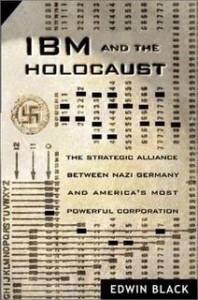IBM and the Holocaust
 “IBM and the Holocaust” by Edwin Black, tells the story of the involvement of this US corporation in the establishment of Hitler’s Third Reich and the destruction of European Jewry.
“IBM and the Holocaust” by Edwin Black, tells the story of the involvement of this US corporation in the establishment of Hitler’s Third Reich and the destruction of European Jewry.
The author of this book, Edwin Black shows how technology developed in America by Herman Hollerith-a punch card and punch card sorting system-enabled the Nazis to organize their war machine and carry through the efficient and systematic genocide of the Jews. At the time of the Nazi dictatorship, IBM had a near worldwide monopoly over the technology and the production of its vital ingredient-the punch cards.
Black explains that ultimately, IBM helped the Nazis carry through their policy of genocide. Without this assistance, Hitler’s regime would not have been able to carry through its extermination plan with such efficiency. IBM’s machines were used at all stages of the persecution of the Jews. They collected the necessary information to identify the Nazis’ victims, first to enforce the bar on Jews working in certain academic, professional, and government jobs and later to carry out mass evictions from their homes and into the ghettoes.
IBM technology was used to organize the railways, so that millions of Nazi victims could be transported to the concentration camps, where they were immediately led into the gas chambers.
There were Hollerith machine departments at nearly every concentration camp, which registered the arrival of inmates, organized the allocation of slave laborers, and even kept tallies on the deaths of prisoners.
IBM was involved in virturally every aspect of the Third Reich’s operations. This book explains that the company leased, serviced and upgraded more than 2,000 machines throughout Nazi occupied Europe.
The punch card technology was first developed by Hollerith, a German-American living in Washington. Through a series of punched holes, each card recorded information on an individual’s gender, religion, nationality, and occupation. Hollerith’s machines were being used to take censuses across the world.
The technology also developed into an early computing system. Thomas Watson, an ex-sewing machine salesman and ruthless businessman, transformed the former company known as the Computing-Tabulating-Recording-Company into what is now known as the International Business Machines.
Watson became a political spokesperson for the German Reich, and IBM in New York carefully supervised the whole process and also would make sure that all technical requirements were provided.
 In 1937, the Nazi regime ordered a nationwide census, in order to assist Hitler in his preparations and “for the Jews it would be the final and decisive identification step”. IBM helped in tracing any Jewish ancestry, and bought 70 card sorters, 60 tabulators, 76 multipliers, and 90 million punch cards. This process assisted Hitler in locating where the Jews were to be rounded up covering all of the Greater Reich’s 22 million households-80 million citizens in Germany, Austria, the Sudentenland, and the Saar.
In 1937, the Nazi regime ordered a nationwide census, in order to assist Hitler in his preparations and “for the Jews it would be the final and decisive identification step”. IBM helped in tracing any Jewish ancestry, and bought 70 card sorters, 60 tabulators, 76 multipliers, and 90 million punch cards. This process assisted Hitler in locating where the Jews were to be rounded up covering all of the Greater Reich’s 22 million households-80 million citizens in Germany, Austria, the Sudentenland, and the Saar.
This pattern would be repeated over and over again in virtually every country that the Nazis occupied. The Nazis relied upon IBM technology. It helped in identifiying Jews and facilitated their transportation to the death camps by train. Without it, the Nazis could not have accomplished their huge task with such ruthless efficiency.
Publication of “IBM and the Holocaust” triggered off a class action lawsuit, which was filed in New York of 2001, which accuses the company of being an accomplice in the Holocaust, and demands that IBM open its archives and pay compensation.
The company continues to deny any responsibility, claiming that its German subsidy was taken over by the Nazis before the war.
I just thought I might shed some light on the most serious crime of the 20th century.

Comments
IBM and the Holocaust — No Comments
HTML tags allowed in your comment: <a href="" title=""> <abbr title=""> <acronym title=""> <b> <blockquote cite=""> <cite> <code> <del datetime=""> <em> <i> <q cite=""> <s> <strike> <strong>